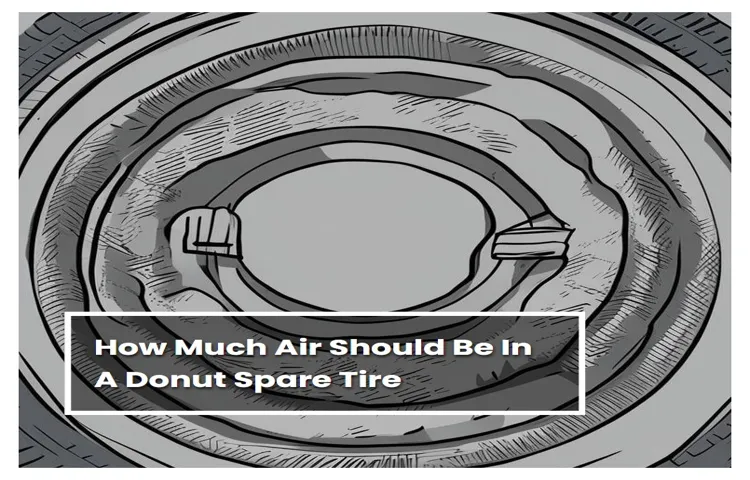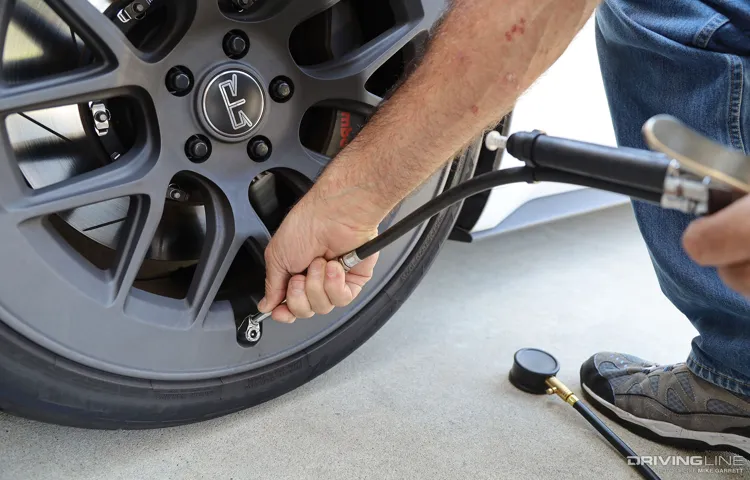Have you ever wondered how much air goes in a donut tire? Maybe you’ve never even heard of a donut tire before, but chances are you’ve seen one on the side of the road. Donut tires, also known as spare or compact tires, are designed to get you back on the road safely after a flat tire. But just how much air do they need to function properly? First, let’s clarify what a donut tire is.
It’s smaller than a regular tire and is typically only intended for temporary use. It’s thinner and narrower, which allows it to fit easily in your trunk. While it’s not meant for driving long distances or at high speeds, it will get you to the nearest service station or tire shop.
Now, back to the question at hand. How much air should you put in a donut tire? The answer is not straightforward. It depends on the size of the tire and the weight of the vehicle it’s carrying.
Generally, donut tires require between 60-70 PSI (pounds per square inch) of air pressure. However, you should always refer to your car’s owner manual for the recommended tire pressure. It’s important to note that overinflating a donut tire can be dangerous, as it can cause the tire to burst.
On the other hand, underinflated tires can lead to poor handling, decreased fuel efficiency, and even tire failure. It’s crucial to keep your donut tire inflated to the correct pressure to ensure your safety on the road. In conclusion, donut tires are a necessary component of any car, but they require special attention when it comes to air pressure.
Always refer to your car’s manual for the recommended tire pressure and avoid overinflating or underinflating your donut tire. With the right amount of air, you’ll be able to safely get back on the road after a flat tire.
Table of Contents
Understanding Donut Tires
If you’ve ever had to use a donut tire as a spare, you might be wondering how much air it needs. Donut tires, also known as space-saver tires, are designed to be compact and lightweight, so they can fit in the trunk of your car and be easily replaced in the event of a flat tire. These tires are not meant for long-term use, as they are smaller than your regular tires and can handle less weight.
As for how much air goes in a donut tire, it typically depends on the make and model of your car. Your owner’s manual should have instructions on how to inflate your donut tire to the appropriate pressure, which is usually between 60-80 psi. It’s important to note that overinflating or underinflating your donut tire can affect its performance and potentially cause further damage to your vehicle, so be sure to follow the manufacturer’s guidelines.
Description of Donut Tires
Donut tires, also commonly referred to as spare tires, are compact and lightweight tires that are utilized as emergency replacements for flat or blown-out tires. They are smaller and thinner in size than regular tires, making them easier to store in the trunk of a car. Despite their convenience, donut tires are not designed for prolonged or high-speed driving, as they lack the same level of stability and durability as regular tires.
They are meant to be used for short distances and at low speeds, typically below 50 miles per hour. It is important to note that using a donut tire for an extended period can cause damage to the wheel or vehicle, and that these tires should only be used as temporary solutions before replacing the damaged tire with a new one.

Pros and Cons of Donut Tires
Donut Tires Donut tires, also known as spare tires, are smaller and thinner than regular tires. They are designed to be a temporary solution in case of a flat tire or a blowout, allowing drivers to make it to the nearest service station safely. Donut tires are usually located in the trunk of a car and come with their own instructions.
One advantage of donut tires is that they take up less space and are lighter than regular tires. This makes them easier to store and transport. However, they have several drawbacks that all drivers should be aware of.
Firstly, donut tires are not suitable for long distances, and they have a limited speed rating. Driving on a donut tire for too long can cause damage to your vehicle’s suspension and alignment. Secondly, donut tires have less traction and stability than regular tires, which can affect your braking and steering abilities.
Finally, not all cars are compatible with donut tires, so you should always check your owner’s manual before purchasing one. Overall, donut tires should be seen as a short-term solution. They are useful in emergencies but should be replaced with a regular tire as soon as possible.
As a driver, you should always ensure that your vehicle is equipped with the right type of tire for the road conditions and your driving habits.
Measuring Air Pressure in Donut Tires
Donut tires, also known as space-saver spare tires, are smaller and lighter than regular tires and are meant to be used only temporarily until you can get to a mechanic to fix or replace your original tire. Due to their size and design, donut tires have a lower recommended air pressure than regular tires. The recommended pressure for a donut tire can usually be found on the sidewall of the tire or in your vehicle’s owner manual.
Generally, donut tires require a pressure of around 55 psi, but this can vary depending on the make and model of the tire and the vehicle it is being used on. It’s important to always check and maintain the correct air pressure in your donut tire to ensure that it performs properly and to prevent any further damage to your vehicle. Driving on an underinflated donut tire can cause it to overheat and potentially burst, leading to a dangerous situation on the road.
So, next time you need to use a donut tire, be sure to check its recommended pressure and inflate it accordingly for a safe and smooth ride.
Tools Needed
Donut tires are a popular choice among drivers because of their compact size and ability to be used on a variety of vehicles. However, since they have a unique shape and construction, measuring air pressure in donut tires can be a bit challenging. To accurately measure the air pressure, you will need a tire pressure gauge that is compatible with the donut tire’s valve stem.
It’s important to make sure the gauge is rated for the appropriate pressure range, which is typically between 25-35 PSI for donut tires. It’s also essential to measure the pressure when the tire is cold because hot tires can provide a false reading. In addition to a pressure gauge, having a tire inflator or air compressor on hand will allow you to inflate the tire to the correct pressure if needed.
By having these tools and following these steps, you can ensure that your donut tires are properly inflated and ready for safe driving.
Step-by-Step Process
Donut tires can bring a unique look and feel to your vehicle, but it’s important to keep them properly inflated to ensure longevity and safety. Measuring air pressure in donut tires is a straightforward process that can be accomplished with a few simple steps. First, locate the valve stem on the tire, typically found on the outer edge of the wheel.
Remove the valve stem cap and use a tire pressure gauge to check the current pressure. If the pressure is too low, use a pump to add air until it reaches the recommended psi for your specific vehicle, which can be found in the owner’s manual or on a sticker inside the driver’s side door. It’s important to check the pressure regularly, especially during temperature changes, as fluctuations can impact tire pressure.
By keeping your donut tires properly inflated, you’ll not only extend their lifespan, but also ensure a safer and smoother ride for you and your passengers.
Recommended Air Pressure Levels
Donut Tires When it comes to measuring air pressure in donut tires, it’s important to know the recommended levels. Donut tires, also known as space-saver or temporary tires, are smaller and narrower than traditional tires. This means they require higher levels of air pressure, typically around 60 PSI.
However, it’s best to consult your vehicle’s manual or a professional mechanic to determine the exact recommended levels for your specific donut tire. Over-inflating or under-inflating your donut tire can lead to various issues, such as poor handling, decreased fuel efficiency, and even blowouts. That’s why it’s crucial to regularly check the air pressure in your donut tire and make adjustments as needed.
By doing so, you can ensure your safety and prolong the lifespan of your temporary tire. So, the next time you encounter a flat, make sure to measure the air pressure in your donut tire and inflate it to the appropriate level.
Maintaining Proper Air Pressure in Donut Tires
If you own a car equipped with a donut tire, you know the importance of maintaining proper air pressure. The recommended air pressure for a donut tire differs slightly from a regular tire, typically falling between 60-80 psi. It’s important to check the pressure regularly using a tire gauge to ensure it stays within the recommended range.
Neglecting to maintain proper air pressure can result in reduced fuel efficiency, premature wear and tear on the tire, and even a blowout when you need the tire the most. Think of maintaining proper air pressure in your donut tire as similar to keeping your body hydrated; it’s essential for optimal performance and longevity. So, next time you check your car’s tire pressure, make sure to give your donut tire the same attention to keep your vehicle rolling safely down the road.
Importance of Maintaining Proper Air Pressure
Maintaining the proper air pressure in your donut tires is crucial for optimal performance and safety. Proper air pressure ensures that your tires maintain their shape and can support the weight of your vehicle, which enhances your car’s stability and handling. Additionally, maintaining the proper air pressure in your tires will help prevent excessive wear and tear on your tires, which can lead to decreased performance and a shorter lifespan.
It is recommended that you check your tire pressure at least once a month and adjust if necessary. By doing so, you can avoid potential issues such as blowouts or increased fuel consumption. A simple check can go a long way in maximizing the lifespan of your donut tires and keeping you safe on the road.
Remember, a little bit of effort can save you money and enhance safety, so do not overlook the importance of maintaining proper air pressure in your donut tires.
Frequency of Checking Air Pressure
Maintaining proper air pressure in donut tires is crucial for ensuring not only your safety but also your vehicle’s performance. The frequency of checking air pressure varies depending on different factors such as the environment, driving conditions, and the type of tire. It is recommended to check your donut tire’s air pressure at least once a month or before long trips.
Underinflated tires can lead to decreased fuel efficiency, uneven wear, and even blowouts. On the other hand, overinflated tires can lead to a harsh ride and premature wear on the tire’s center. Therefore, it is essential to maintain proper air pressure according to the manufacturer’s recommended levels.
Checking the tire’s air pressure is a quick and easy process that can be done at home using a tire pressure gauge. It is always better to be safe than sorry, so don’t forget to include checking your donut tire’s air pressure in your regular car maintenance routine.
Tips for Maintaining Proper Air Pressure
Maintaining proper air pressure in your donut tires is crucial for ensuring efficient driving and preventing tire damage. One tip for maintaining the correct air pressure is to check the tire pressure at least once a month and before going on a long drive. Use a tire pressure gauge to check the tire pressure, which should be indicated in your vehicle’s manual or on a sticker on the driver’s side door jamb.
Additionally, make sure to inflate your tires to the recommended pressure level, rather than overinflating or underinflating them. Overinflated tires can lead to decreased traction and stability, while underinflated tires can cause excessive wear and damage to the tire. By following these tips and regularly checking your tire pressure, you can ensure that your donut tires will last longer and perform better on the road.
Conclusion
In conclusion, the amount of air that goes into a donut tire is dependent on various factors, including the vehicle’s weight, the type of tire, and the desired pressure. But one thing’s for sure, just like how a donut can be filled with different flavors and toppings, so can a donut tire be filled with different levels of air pressure to accommodate various road conditions. So, whether you’re dealing with a flat on the highway or just a hankering for a sweet treat, remember that just like donuts, there’s always a perfect amount of air for your tire, waiting to be discovered.
“
FAQs
What is a donut tire?
A donut tire is a spare tire that is smaller and thinner than a regular tire.
Can you drive on a donut tire for a long distance?
No, donut tires are meant to be temporary and should not be driven for long distances.
How much air pressure should a donut tire have?
The recommended air pressure for a donut tire is usually printed on the tire or in the owner’s manual.
How long can you drive on a donut tire before replacing it?
Donut tires are only meant to be used as temporary spares and should be replaced as soon as possible.
Can you use a donut tire on any type of vehicle?
No, donut tires are only meant to be used on vehicles that are specifically designed to accommodate them.
How does a donut tire affect vehicle performance?
Donut tires can have a negative effect on vehicle handling, braking, and stability because they are smaller and thinner than regular tires.
What should you do if you have a flat tire and only have a donut spare?
Use the donut spare to drive to a safe location and then replace it with a regular tire as soon as possible.


